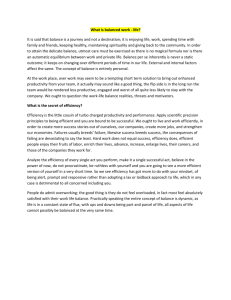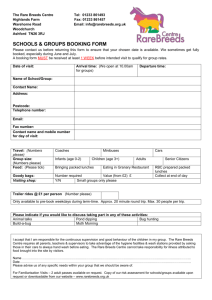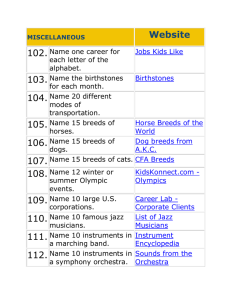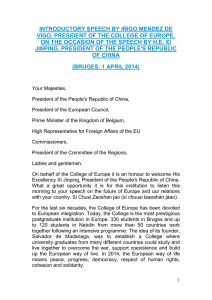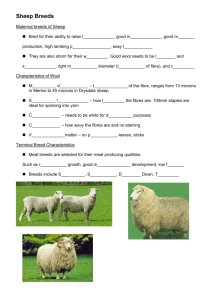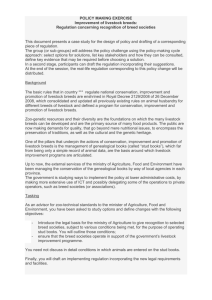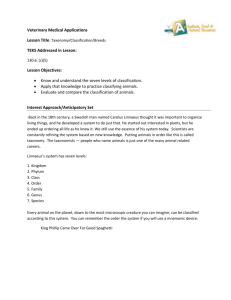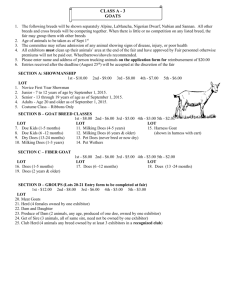Article - Department of Library Services
advertisement
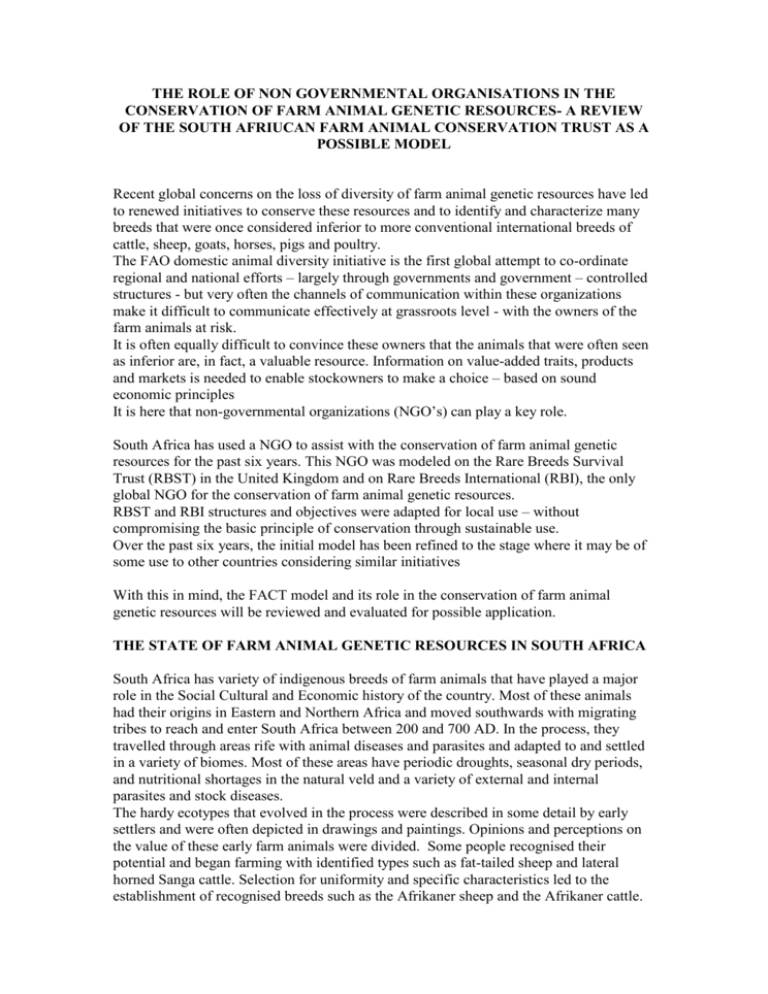
THE ROLE OF NON GOVERNMENTAL ORGANISATIONS IN THE CONSERVATION OF FARM ANIMAL GENETIC RESOURCES- A REVIEW OF THE SOUTH AFRIUCAN FARM ANIMAL CONSERVATION TRUST AS A POSSIBLE MODEL Recent global concerns on the loss of diversity of farm animal genetic resources have led to renewed initiatives to conserve these resources and to identify and characterize many breeds that were once considered inferior to more conventional international breeds of cattle, sheep, goats, horses, pigs and poultry. The FAO domestic animal diversity initiative is the first global attempt to co-ordinate regional and national efforts – largely through governments and government – controlled structures - but very often the channels of communication within these organizations make it difficult to communicate effectively at grassroots level - with the owners of the farm animals at risk. It is often equally difficult to convince these owners that the animals that were often seen as inferior are, in fact, a valuable resource. Information on value-added traits, products and markets is needed to enable stockowners to make a choice – based on sound economic principles It is here that non-governmental organizations (NGO’s) can play a key role. South Africa has used a NGO to assist with the conservation of farm animal genetic resources for the past six years. This NGO was modeled on the Rare Breeds Survival Trust (RBST) in the United Kingdom and on Rare Breeds International (RBI), the only global NGO for the conservation of farm animal genetic resources. RBST and RBI structures and objectives were adapted for local use – without compromising the basic principle of conservation through sustainable use. Over the past six years, the initial model has been refined to the stage where it may be of some use to other countries considering similar initiatives With this in mind, the FACT model and its role in the conservation of farm animal genetic resources will be reviewed and evaluated for possible application. THE STATE OF FARM ANIMAL GENETIC RESOURCES IN SOUTH AFRICA South Africa has variety of indigenous breeds of farm animals that have played a major role in the Social Cultural and Economic history of the country. Most of these animals had their origins in Eastern and Northern Africa and moved southwards with migrating tribes to reach and enter South Africa between 200 and 700 AD. In the process, they travelled through areas rife with animal diseases and parasites and adapted to and settled in a variety of biomes. Most of these areas have periodic droughts, seasonal dry periods, and nutritional shortages in the natural veld and a variety of external and internal parasites and stock diseases. The hardy ecotypes that evolved in the process were described in some detail by early settlers and were often depicted in drawings and paintings. Opinions and perceptions on the value of these early farm animals were divided. Some people recognised their potential and began farming with identified types such as fat-tailed sheep and lateral horned Sanga cattle. Selection for uniformity and specific characteristics led to the establishment of recognised breeds such as the Afrikaner sheep and the Afrikaner cattle. Others began crossbreeding these animals with imported breeds to ‘improve’ them - and to make them more acceptable to those accustomed to the more uniform and ‘blocky’ European and British breeds of the time. A number of the early breeds are still here to this day. Some, like the Nguni and Afrikaner cattle and the improved Boer goat have been commercialised and are at no risk - while others have been severely depleted by continued crossbreeding and replacement. The future of the latter breeds is largely dependent on their economic value – either as pure breeds – or as a source of much needed traits such as disease and parasite tolerance and general hardiness. Characterising breeds, investigating value added traits and developing products and markets is part of the value adding and information process. To be effective, information must flow to all levels – and genetic material must be available to all levels as well. Where a breed has no immediate economic value, it needs to be conserved for possible later use – and where a breed is endangered, all efforts should be made to preserve it and increase numbers. These actions and initiatives need to involve all role players and stakeholders – from Government ratification of the United Nations Convention on Biological diversity, Policy makers, Government and Provincial Agriculture, Research institutes, Universities, Museums, Organised Agriculture, Breed Societies, Producer organisations to the stock owner. Very often, the most effective way of facilitating effective communication between all the parties is through an umbrella organisation. This was one of the main objectives in establishing FACT. THE ROLE OF THE FARM ANIMAL CONSERVATION TRUST (FACT) The Farm Animal Conservation Trust (FACT) was established in 1994 as the Association for the Conservation of Early Domesticated Animals in South Africa (ACEDA) with a mandate to facilitate and promote the conservation of South Africa’s indigenous farm animal genetic resources. FACT activities include the dissemination of information on lesser-known and endangered farm animals and facilitating conservation through the sustainable use of these breeds in commercial farming systems. FACT is an active partner in a National initiative to create awareness and markets and to add value. This partnership includes the National Department of Agriculture, the Agricultural Research Council, the National Cultural History Museum and Universities. Founding Workshop and basic constitution FACT started life as ACEDA after a founding workshop assisted by the Secretary General of RBI and Executive Director of RBST, Lawrence Alderson. This was an opportunity to invite all possible stakeholders and role players to a symposium to discuss the need for a breed conservation organization. In reviewing the progress of FACT, it was undoubtedly the most effective way to initiate the establishment of the NGO – and an effective way to get support from the State and Parastatal organizations involved at the time. Collection of information on FanGR One of the first initiatives was to establish a database of information on FAnGR. All the available literature was collected, catalogued and stored at the Irene Animal Improvement Institute. This includes Archaeo-Zoological, Historical, Popular and Scientific publications on the origin and development of early-domesticated breeds. This data has been used to produce a number of posters on the breeds in question and these are now used on a regular basis at shows and exhibitions to create an awareness of the importance of South Africa’s early domesticated farm animals Collection of breeds The Willem Prinsloo Agricultural Museum outside Pretoria was the ideal site for a collection of breeds. This is a farm museum with all the necessary facilities – including conference and catering facilities. Breed Societies and breeders were approached for donations of animals. Other animals were purchased. From the onset, it was decided to establish breeding units to be able to place animals at other strategic centers at a later stage. The initial collection included the following breeds Afrikaner sheep Persian sheep Pedi sheep Zulu sheep Damara sheep Kolbroek pigs Nguni cattle Indigenous poultry breeds/varieties Exhibitions and shows Breeds were exhibited at a number of agricultural shows and festivals. Posters with basic information on the breeds and a basic information leaflet were also made available. Exhibitions have now been stabilized to include shows where public support and interest justifies the expense. Table 1 gives details of shows and exhibitions from 1995 to 1999 TABLE 1. - FACT ACTIVITIES OVER THE PAST FIVE YEARS Agricultural shows Symposiums Farm festivals 1995 1996 1997 1998 1999 1 1 1 1 1 1 Permanent exhibitions at Zoos and farm parks Animals were placed at the Pretoria zoo farm animal section and a permanent exhibit of Zulu cattle and sheep is under development at the Johannesburg Zoo. The Zoo projects could become breeding units for further distribution and exchange of genetic material In addition, a permanent exhibition has been established at the Rooihuiskraal site in the Centurion Municipal area. This development could be the start of similar initiatives that would help promote public awareness of South Africa’s indigenous and locally developed livestock resources Annual show and sale In order to promote the sustainable use of early-domesticated breeds, FACT held the first show and sale of breeds during 1999. This was based on the RBST show and sale concept and is aimed at public awareness, the further distributions of genetic material and broadening the emerging farmer sector’s access to markets for their indigenous breeds. This will become an annual event – and will move to a more central locality for the 2001 sale. Publications The publication of a booklet on South Africa’s Indigenous and Locally developed breeds was as a key factor in the ongoing promotion and marketing of genetic material. FACT published the booklet to facilitate the marketing of Landrace breeds as part of an initiative to conserve through commercial utilisation. Information on production environments was included to help match animals with effective farming systems. It also serves as a useful reference on value - adding traits that are often overlooked - and that could give the breeds in question a competitive edge. Breed information can also be used by the resource poor farmer to identify animals that have added value as indigenous breeds. This will serve as a link between the owners of these animals and potential markets and services. This will hopefully also contribute to the emergence of commercial breeders of landraces in the resource poor sector and to the long-term stability of breeds Using the FACT experience to develop a model Survey to determine interest Workshop Establish a conservation NGO Identify a suitable in situ site for a breed collection Investigate and develop satellite units Distribute information on breeds and exhibit at key shows Publish a reference book on rare /endangered breeds Promote Conservation through sustainable use Establish a show and sale policy Concluding remarks The Farm Animal Conservation trust has been fairly effective in creating an awareness of the value of South Africa’s indigenous and locally developed breeds – some of which can be classified as endangered. A combination of live exhibits, posters and leaflet information that can be set up at strategic events has been effective in generating interest in the breeds and has led to the emergence of satellite breeding and conservation units. The most important fact, however, is to remain focused on conservation through sustainable use and to encourage farmers to use the breeds in question as a viable alternative. State and Parastatal support is important – and having a ‘home’ for breeds – either at a farm park – or a research and development institute that is easily accessible will
